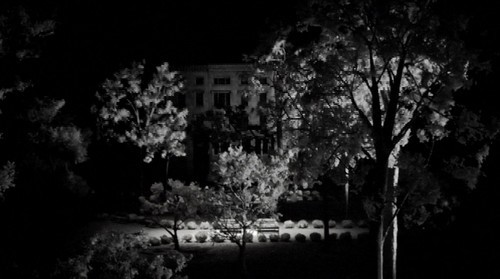Jonas Dahlberg
12 Mar - 26 May 2009
JONAS DAHLBERG
“View Through a Park“
March 12 - May 26
In Jonas Dahlberg’s new film View Through a Park (2009), the viewer follows a single camera movement from the interior of one apartment, though an idyllic city park, to its facing apartment. Set at night, the dreamlike shot travels endlessly between these two buildings.
Unlike Alfred Hitchcock’s Rear Window (1954) where the voyeuristic gaze is achieved with a zoom lens, the viewer in View Through a Park travels with the gaze, thereby revealing the physicality of seeing. The gaze is not voyeuristic until it reaches its destination. Dahlberg nods his hat to Michelangelo Antonioni’s film The Passenger from 1975 - the transition from inside to outside through the glass of the window is seamless and thereby non-physical. Inside the apartment the movement is that of a searching eye in a domestic space - the viewer becomes a silent intruder.
In The Passenger the camera movement and narrative development allow closure. Here, the continuous motion from one space to another is repeated, unfolding infinitely and suggesting no beginning or end. The apartments mirror one another, like non-identical twins, creating an odd and static familiarity, confusing time and space.
View Through a Park is shot in colour but presents an environment that is black and white in actuality. This inverted method of filming a black and white world in color increases the sense of nostalgia and melancholy in the film, suggesting the feeling one is observing something deceased.
The architecture is modeled on Gramercy Park in New York, which is the only remaining private park in Manhattan. Such surroundings relate to any community where the residents attempt to create a closed and controlled environment in order to stop time and secure a nostalgic or romanticized ideal of living. Today these privately controlled public areas are expanding and create new kinds of secret cities both inside and outside existing cities. These spaces suggest paranoia and fear but also certain kind of melancholy, as only such isolation can produce.
“View Through a Park“
March 12 - May 26
In Jonas Dahlberg’s new film View Through a Park (2009), the viewer follows a single camera movement from the interior of one apartment, though an idyllic city park, to its facing apartment. Set at night, the dreamlike shot travels endlessly between these two buildings.
Unlike Alfred Hitchcock’s Rear Window (1954) where the voyeuristic gaze is achieved with a zoom lens, the viewer in View Through a Park travels with the gaze, thereby revealing the physicality of seeing. The gaze is not voyeuristic until it reaches its destination. Dahlberg nods his hat to Michelangelo Antonioni’s film The Passenger from 1975 - the transition from inside to outside through the glass of the window is seamless and thereby non-physical. Inside the apartment the movement is that of a searching eye in a domestic space - the viewer becomes a silent intruder.
In The Passenger the camera movement and narrative development allow closure. Here, the continuous motion from one space to another is repeated, unfolding infinitely and suggesting no beginning or end. The apartments mirror one another, like non-identical twins, creating an odd and static familiarity, confusing time and space.
View Through a Park is shot in colour but presents an environment that is black and white in actuality. This inverted method of filming a black and white world in color increases the sense of nostalgia and melancholy in the film, suggesting the feeling one is observing something deceased.
The architecture is modeled on Gramercy Park in New York, which is the only remaining private park in Manhattan. Such surroundings relate to any community where the residents attempt to create a closed and controlled environment in order to stop time and secure a nostalgic or romanticized ideal of living. Today these privately controlled public areas are expanding and create new kinds of secret cities both inside and outside existing cities. These spaces suggest paranoia and fear but also certain kind of melancholy, as only such isolation can produce.

